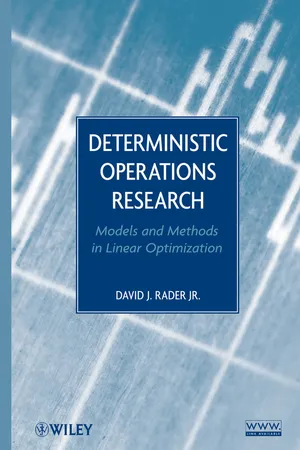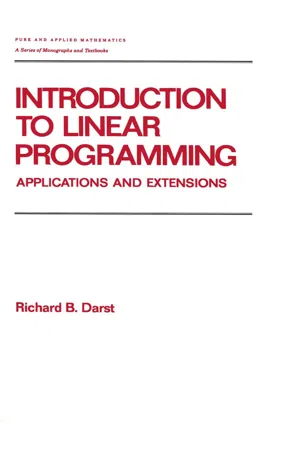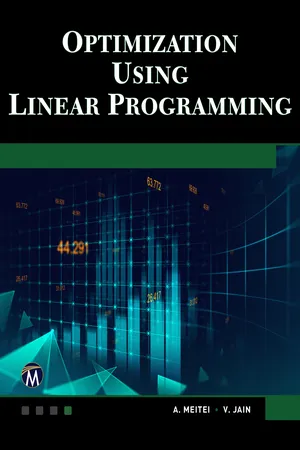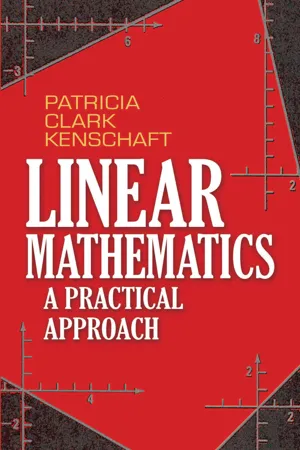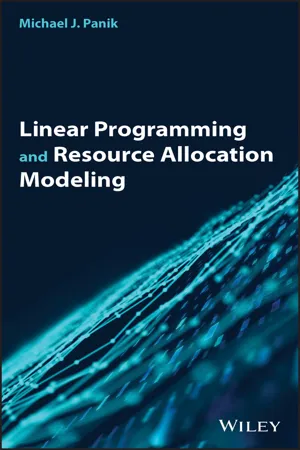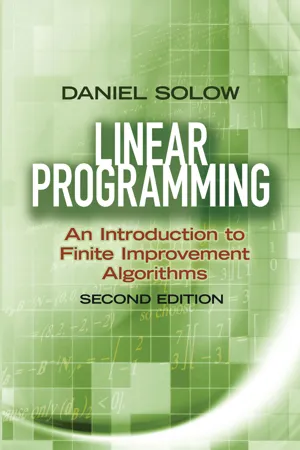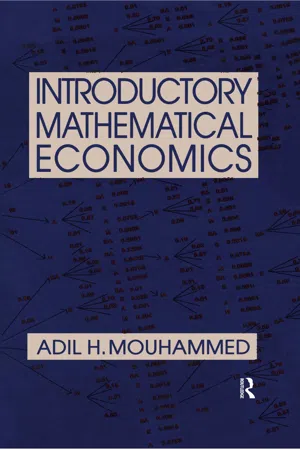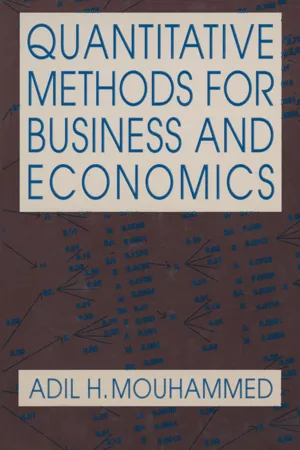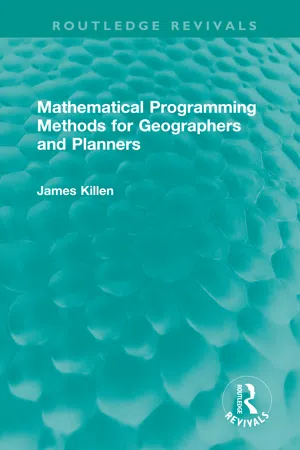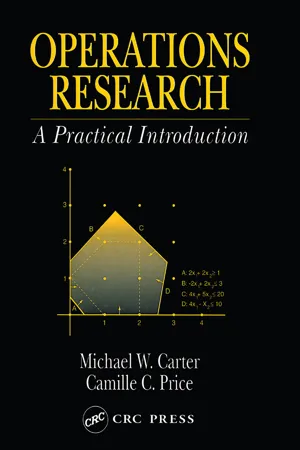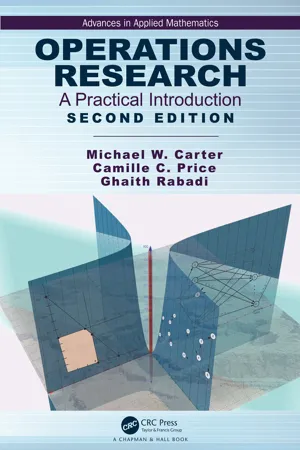Mathematics
The Simplex Method
The Simplex Method is a popular algorithm used for solving linear programming problems. It involves iteratively moving from one feasible solution to another in order to optimize a linear objective function, typically in the context of resource allocation or optimization. The method is widely used in operations research and mathematical modeling to find the best solution among a set of feasible options.
Written by Perlego with AI-assistance
Related key terms
Related key terms
1 of 4
Related key terms
1 of 3
12 Key excerpts on "The Simplex Method"
- eBook - ePub
Deterministic Operations Research
Models and Methods in Linear Optimization
- David J. Rader(Author)
- 2013(Publication Date)
- Wiley(Publisher)
CHAPTER 8SOLVING LINEAR PROGRAMS: SIMPLEX METHOD
The previous two chapters introduced some basic concepts in optimization, such as improving search methods and the geometry and algebra of linear programs. We now combine these topics to produce an algorithm for solving linear programs called the Simplex Method. The Simplex Method is the most widely used optimization algorithm, solving daily thousands of real-world problems for business, industry, academe, and other scientific outlets. Various implementations routinely solve problems with millions of constraints and tens of millions of variables. In this chapter, we learn the fundamentals of The Simplex Method, how to implement it efficiently, and how it deals with various “problem areas.”8.1 SIMPLEX METHOD
The Simplex Method is a specialized version of the general improving search algorithm (Algorithm 6.2) that is designed to take advantage of the properties of linear programs. Like many improving search algorithms, The Simplex Method moves from feasible solution to feasible solution, improving the objective function value at each step; however, The Simplex Method examines only certain types of solutions.Because linear programs can appear in many equivalent forms, we concentrate on solving only linear programs expressed in the canonical form(8.1)with m constraints and n variables. We assume the rank of , a is m and that m ≤ n . From the fundamental theorem of linear programming (Theorem 7.5), if a linear program has an optimal solution then at least one such solution exists at a basic feasible solution, which implies that we need to consider only basic feasible solutions. For a linear program in canonical form (8.1), a basic feasible solution is a solution for which the variables are partitioned into m basic variables and n − m nonbasic variables, the columns of , a associated with the basic variables (denoted by the matrix B ) are linearly independent, the values of the nonbasic variables xN are zero, and the values of the basic variables xB uniquely solve B xB = b - eBook - ePub
- Bernard Kolman, Robert E. Beck(Authors)
- 1995(Publication Date)
- Academic Press(Publisher)
2The Simplex Method
IN THIS CHAPTER we describe an elementary version of the method that can be used to solve a linear programming problem systematically. In Chapter 1 we developed the algebraic and geometric notions that allowed us to characterize the solutions to a linear programming problem. However, for problems of more than three variables, the characterization did not lead to a practical method for actually finding the solutions. We know that the solutions are extreme points of the set of feasible solutions. The method that we present determines the extreme points in the set of feasible solutions in a particular order that allows us to find an optimal solution in a small number of trials. We first consider problems in standard form because when applying the method to these problems it is easy to find a starting point. The second section discusses a potential pitfall with the method. However, the difficulty rarely arises and has almost never been found when solving practical problems. In the third section, we extend the method to arbitrary linear programming problems by developing a way of constructing a starting point.2.1 The Simplex Method FOR PROBLEMS IN STANDARD FORM
We already know from Section 1.5 that a linear programming problem in canonical form can be solved by finding all the basic solutions, discarding those that are not feasible, and finding an optimal solution among the remaining. Since this procedure can still be a lengthy one, we seek a more efficient method for solving linear programming problems. The simplex algorithm is such a method; in this section we shall describe and carefully illustrate it. Even though the method is an algebraic one, it is helpful to examine it geometrically.Consider a linear programming problem in standard form(1)subject to(2)(3)where A = [a ij ] is an m × n matrix andIn this section we shall make the additional assumption that b ≥ 0 . In Section 2.3 we will describe a procedure for handling problems in which b - eBook - ePub
Introduction to Linear Programming
Applications and Extensions
- Richard Darst(Author)
- 2020(Publication Date)
- CRC Press(Publisher)
4 Introduction to The Simplex MethodThe Simplex Method is essentially an algorithm that systematically examines basic feasible solutions of a standard-form LP for optimality. The discussion begins with some preliminary simplifications and then proceeds to set forth our notation and recall some pertinent algebra. The section headings provide you with a list of the major parts of the method for easy reference. There are many variations of The Simplex Method and there are newer methods. Exploring the books on the Reading List and the references in those books will expose you to a vast literature on LP; this chapter is merely an introduction.Preliminary Simplifications
The Simplex Method assumes that you have an initial basic feasible solution (BFS) with which to begin. Section 4.11 shows how to determine whether a BFS exists and how to find a BFS when one exists. Thus, without incurring any loss of generality, suppose that we have an initial BFS with which to begin The Simplex Method. We can make two other preliminary simplifications without loss of generality: Suppose that the m × n marix A has rank m and suppose that b ≥ 0.4.1 Notation
Suppose that x is a BFS withxt> 0 for 1 ≤ i ≤ p and = 0 for p < i ≤ n .Basic Fact
According to basic (pun intended) linear algebra, we can choose m – p columns in the set {ap +1,…,an} of columns of A and relabel them if necessary, so that they are labeled ap +1,…,am, and together withai,…,ap, compose a set {a 1 ,…, a p , ap +1,…,am} of m linearly independent vectors inRm. Thus we can label the columns of A so that A = [a 1 , a 2 , · · ·,am, am +1,…,an] = [B | V ], where B = [a 1 ,…,am] and V = [am +1,…,an]; B has rank m and the columns of B are a basis forRm. Any vector v inRmcan be written uniquely as a linear combination of a 1 ,a 2 ,…,am; row reduction can be used to determine which combination. For instance, considering the basic feasible solution x = (2,0,0,0) in Example 3.2 , p = 1 and m = 2, so m − p = 1; any one of the columns a 2 = (0,1), a 3 = (0, −2), or a 4 = (1,3) can be chosen and relabeled, if necessary, to become the second column in B ; B is called a B - eBook - ePub
- A. J. Metei, Veena Jain(Authors)
- 2019(Publication Date)
- Mercury Learning and Information(Publisher)
and such a case needs to be handled differently. For the time being, we assume that we do not have this situation.3.4.Relationship between the Simplex and Graphical Methods
Now that it can be seen that The Simplex Method is similar to solving a system of linear equations. In fact, this method does solve a system of linear equations (to be discussed in next chapter) and the solution is derived. Further, the method not only solves the equations but also optimizes the objective function of the problem. There are a number of methods for solving simultaneous linear equations. For example, the Gauss-Jordan method discussed in Chapter 1 is one such method which has a close relation to the simplex calculation.The Simplex Method as seen previously is an iterative method of solving a given linear programming problem. The method starts its calculation with an initial basic feasible solution and then repeats the solution process by removing one basic variable from the basis and allowing another from the non-basic variables to enter the basis, making successive improvements until the optimal solution is found. It is sometimes referred to as an adjacent extreme point solution procedure because it generally begins at a feasible extreme point and then successively evaluates the adjacent extreme point until one representing the optimal solution is found. It may be recalled that in the graphical method the optimum solution (if it exists) of a problem is found at one of the extreme points. To understand this more deeply, we consider Example 3.5 of the previous section:Maximize z = 4x1 + x2Subject to the constraints:Fig. 3.1Let The Simplex Method start its calculation at the origin (0, 0), which means at this point x1 and x2 are both non-basic variables. Now, since in the objective function equation x1 has a larger coefficient than x2 , we shall allow x1 - eBook - ePub
Linear Mathematics
A Practical Approach
- Patricia Clark Kenschaft(Author)
- 2013(Publication Date)
- Dover Publications(Publisher)
Chapter 6 THE SIMPLEX ALGORITHM6.1 Solving Standard Linear Programming Problems Using the Simplex AlgorithmThe linear programming problems in Chapter 5 included both nonnegativity constraints and other constraints. We shall refer to the constraints in any linear programming problem that are not nonnegativity constraints as significant constraints . These will be the constraints of primary interest, since whenever The Simplex Method is used, all the independent variables are assumed to be nonnegative . Thus the nonnegativity constraints are often not written, but simply understood.A linear programming problem is said to be standard if the objective function is to be maximized and if all the significant constraints are of the form a1 x1 + a2 x2 + … + an xn ≤ b where the ai and b are constants (b ≥ 0) and the xiare variables. Section 5.2 and 5.3 discussed only standard linear programming problems, as will this section and the next. In Section 7.1 we shall see that every standard linear programming problem can be expressed in the form “Maximize P = DX when AX ≤ B,” where D is a row vector, B is a column vector, A is a matrix, and all the elements in B are nonnegative.An algorithm is a method for solving a particular type of routine problem. The simplex algorithm (or method) is a mathematical technique that was developed in the middle of the twentieth century for the purpose of solving linear programming problems. This section shows how to use the simplex algorithm to solve standard linear programming problems. The next section explains more of the reasoning behind the algorithm, and Section 6.3 shows how it can be adapted to linear programming problems that are not in standard form.The simplex algorithm uses a basic idea from the tabular method-that of examining vertices of the feasible region. But only certain vertices are examined by the simplex algorithm. Each such vertex is described by a simplex tableau; a series of tableaux are written, each one describing a vertex adjacent to the one described by the previous tableau. In each tableau the value of the objective function is increased over the value in the previous tableau. When the objective function can increase no more, we have reached the maximum, and the location of the corresponding vertex can be read off the tableau. A standard linear programming problem always includes the origin as one of its feasible points; thus the first tableau can and will always describe the origin. - Michael J. Panik(Author)
- 2018(Publication Date)
- Wiley(Publisher)
4 Computational Aspects of Linear Programming4.1 The Simplex Method
We noted in the previous chapter that the region of feasible solutions has a finite number of extreme points. Since each such point has associated with it a basic feasible solution (unique or otherwise), it follows that there exists a finite number of basic feasible solutions. Hence, an optimum solution to the linear programming problem will be contained within the set of basic feasible solutions to How many elements does this set possess? Since a basic feasible solution has at most m of n variables different from zero, an upper bound to the number of basic feasible solutions isi.e. we are interested in the total number of ways in which m basic variables can be selected (without regard to their order within the vector of basic variables XB) from a group of n variables. Clearly for large n and m it becomes an exceedingly tedious task to examine each and every basic feasible solution. What is needed is a computational scheme that examines, in a selective fashion, only some small subset of the set of basic feasible solutions. Such a scheme is the simplex method (Dantzig 1951 ). Starting from an initial basic feasible solution, this technique systematically proceeds to alternative basic feasible solutions and, in a finite number of steps or iterations, ultimately arrives at an optimal basic feasible solution. The path taken to the optimum is one for which the value of the objective function at any extreme point is at least as great as at an adjacent extreme point (two extreme points are said to be adjacent if they are joined by an edge of a convex polyhedron). For instance, if in Figure 4.1 the extreme point A represents our initial basic feasible solution, the first iteration slides f upwards parallel to itself over 풦 until it passes through its adjacent extreme point B. The next iteration advances f in a similar fashion to its optimal (maximal) basic feasible solution at C. So with f nondecreasing between successive basic feasible solutions, this search technique does not examine all basic feasible solutions but only those that yield a value of f- eBook - ePub
- Daniel Solow(Author)
- 2014(Publication Date)
- Dover Publications(Publisher)
Chapter 5The Simplex Algorithm
All of the preliminary work is now complete. This chapter will develop the simplex algorithm, which, in a finite number of steps, will determine if an LP in the standard form
is infeasible, optimal, or unbounded. If the LP is unbounded, a direction of unboundness will be produced; if the LP is determined to be optimal, then an optimal solution will be produced.Minimize cx subject to Ax = b x ≥ 0 5.1. BASIC FEASIBLE SOLUTIONS
Throughout this chapter, it will be helpful to recall the geometric and conceptual motivation of the simplex algorithm that was presented in Chapter 2 . That information is summarized in Table 5.1 .From Table 5.1 you can see that the geometric approach suggests moving from one extreme point of the feasible region to another. Unfortunately, computers cannot solve problems geometrically, and so algebra becomes necessary. Consequently, the first step in designing an algebraic method is to develop an algebraic representation of an extreme point. That concept is referred to as a basic feasible solution (hereafter called a bfs). The simplex algorithm will move algebraically from one bfs to another while trying to decrease the objective value each time.TABLE 5.1. Geometric and Conceptual Approach of the Simplex AlgorithmConceptual Geometric The problem: GivenColored balls in a box Extreme points of the feasible region ObjectiveFind a red ball Find one with the smallest objective value The algorithm: 0. InitializationPick a ball from the box Find an initial extreme point 1. Test for optimalityIs the ball red? Does it have the smallest objective value? - eBook - ePub
- Adil H. Mouhammed(Author)
- 2020(Publication Date)
- Routledge(Publisher)
Chapter SevenLinear Programming I: The Simplex Method
Economics was defined by Lionel Robbins (1932) as the science of studying the allocation of scarce economic resources among competing ends, that is, economics is concerened with making choices and decisions. Similarly, linear programming is a mathematical theory by which the available economic resources can be allocated efficiently for achieving a certain goal.Linear programming was developed independently by Leonid Kantorovich and T.C. Koopmans; both shared the Nobel prize in economics in 1975 for developing this mathematical model (Kantorovich 1960,1965; Koopmans 1951). Kantorovich was able to find a mathematical model by which the available economic resources in the Soviet Union could be allocated efficiently. Kantorovich, however, was not able to develop an algorithm by which a linear mathematical program can be solved. This task was left to George Dantzig to develop in 1947 (Dantzig 1963). Since then economists such as Dorfman (1953), Dorfman et al. (1958), and Baumol (1977) have applied the model of linear programming to a variety of real world problems in transportation, accountancy, finance, diet, the military, agriculture, and human resources, to mention a few.A Problem’s Formulation and Assumptions
The most difficult part of linear programming is the formulation of a particular segment of the real world in a linear mathematical programming context (Taha 1987; Thompson 1976; Lapin 1991). In fact, the formulation of a linear programming problem is an art that must be learned from experience rather than a textbook. Mathematically, a mathematical linear program is written asMaximize Z = c1 X1 + c2 X2 + c3 X3 + ... + cn XnSubject toa 11X 1+a1 2X 2+ ... +a lnX n≤b 1a 21X 1+a 22X 2+ ... +a2 nX n≤b 3...................................a3 1X 1+a3 2X 2+ ... +a3 nX n≤b 3am 1X 1+am 2X 2+ ... +am nX n≤b mX 1≥ 0 ,X 2≥ 0 - eBook - ePub
- Adil H. Mouhammed(Author)
- 2015(Publication Date)
- Routledge(Publisher)
CHAPTER SEVENLinear Programming I: The Simplex Method
Economics was defined by Lionel Robbins (1932) as the science of studying the allocation of scarce economic resources among competing ends, that is, economics is concerened with making choices and decisions. Similarly, linear programming is a mathematical theory by which the available economic resources can be allocated efficiently for achieving a certain goal.Linear programming was developed independently by Leonid Kantorovich and T.C. Koopmans; both shared the Nobel prize in economics in 1975 for developing this mathematical model (Kantorovich 1960,1965; Koopmans 1951). Kantorovich was able to find a mathematical model by which the available economic resources in the Soviet Union could be allocated efficiently. Kantorovich, however, was not able to develop an algorithm by which a linear mathematical program can be solved. This task was left to George Dantzig to develop in 1947 (Dantzig 1963). Since then economists such as Dorfman (1953), Dorfman et al. (1958), and Baumol (1977) have applied the model of linear programming to a variety of real world problems in transportation, accountancy, finance, diet, the military, agriculture, and human resources, to mention a few.A Problem’s Formulation and Assumptions
The most difficult part of linear programming is the formulation of a particular segment of the real world in a linear mathematical programming context (Taha 1987; Thompson 1976; Lapin 1991). In fact, the formulation of a linear programming problem is an art that must be learned from experience rather than a textbook. Mathematically, a mathematical linear program is written asMaximize Z = c1 X1 + c2 X2 + c3 X3 + … + Cn XnSubject toa11 X1 + a12 X2 + … + a1n Xn ≤ b1a21 X1 + a22 X2 + … + a2n Xn ≤ b2a31 X1 + a32 X2 + … + a3n Xn ≤ b3…………………am1 X1 + am2 X2 + … + amn Xn ≤ bm - James Killen(Author)
- 2021(Publication Date)
- Routledge(Publisher)
Two characteristics of the foregoing solution method should be noted. First, the method is obviously limited in application: if, for example, there were three decision variables e.g. three possible housetypes, a three dimensional diagram would be necessary with the constraints being represented by planar surfaces. This would be difficult although not impossible to draw. If, however, there were more than three decision variables as is usually the case in real world problems, it would not be possible to represent the objective and constraints diagrammatically. For this reason, we must seek an alternative method for solving such problems.The second point to note in the foregoing problem is that its structure is such that the optimal solution will (nearly) always lie at one of the outermost corners of the solution space. (We shall assume for the moment that this is always the case.) The importance of this observation is that for a given problem, it reduces the number of possible places where the optimal solution might lie: the solution space in Figure 4.1(c) comprises an infinite number of points but there are only five outer corner points 0, A1 , S, U and C2 . This in its turn suggests a method for seeking the optimal solution: the solution associated with the various outer corner points of the solution space should be examined in some logical order until such time as it is known that the corner point associated with the best solution has been reached. This is, in fact, the logic underlying The Simplex Method.4.4 PRELIMINARIES TO The Simplex Method
Certain mathematical ideas required for an understanding of The Simplex Method are described in this section. For convenience, it is assumed that a maximisation problem with a number of ‘less than or equals’ constraints together with the usual non-negativity conditions is to be solved. The numerical example solved via the graphical method in the previous section is retained as the illustrative example.4.4.1 Standard Form Representation
The Simplex Method comprises an algebraic method for finding the optimal solution to a linear programming problem. Given that most algebraic methods deal with equalities rather than inequalities, it is not surprising that The Simplex Method commences by restating the problem to be solved in terms of equations.- eBook - ePub
Operations Research
A Practical Introduction
- Michael W. Carter, Camille C. Price(Authors)
- 2017(Publication Date)
- CRC Press(Publisher)
binding constraints.)If we examine a graphical representation of the feasible region of this linear programming problem in Figure 2.6 , we can observe the progression from extreme point A (initial solution) to extreme point B, then C, and finally the optimal solution at point D. Extreme points F and G are infeasible, and point E is a basic feasible solution but is not examined by The Simplex Method.FIGURE 2.6 Simplex steps.In summary, let us briefly review the steps of the Simplex algorithm and the rationale behind each step. Negative coefficients, corresponding to non-basic variables, in the objective function row indicate that the objective function can be increased by making those associated variables basic (non-zero). If in Step 1 we find no negative element, then no change of basis can improve the current solution. Optimality has been achieved and the algorithm terminates.Otherwise, in Step 2, we select the non-basic variable to enter the basis that has the greatest potential to improve the objective function. The elements in the objective function row indicate the per unit improvement in the objective function that can be achieved by increasing the non-basic variables. Because these values are merely indicators of potential and do not reveal the actual total improvement in z, ties are broken arbitrarily. In actual practice, choosing the most negative coefficient has been found to use about 20% more iterations than some more sophisticated criteria, such as are suggested by [Bixby, 1994].The basic variable to be replaced in the basis is chosen, in Step 4, to be the basic variable that reaches zero first as the entering variable is increased from zero. We restrict our examination of pivot column elements to positive values only (Step 3) because a pivot operation on a negative element would result in an unlimited increase in the basic variable. If the pivot column elements are all negative or zero, then the solution is unbounded and the algorithm terminates here. Otherwise, a pivot operation is performed as described in Step 5. - eBook - ePub
Operations Research
A Practical Introduction
- Michael Carter, Camille C. Price, Ghaith Rabadi(Authors)
- 2018(Publication Date)
- Chapman and Hall/CRC(Publisher)
Section 2.3.3 that when the line corresponding to the objective function is parallel to one of the straight lines bounding the feasible region, then the objective function can be optimized at all points on that edge of the feasible region. Thus, instead of a unique optimal solution, we have infinitely many optimal solutions from which to choose, thereby permitting management to select on the basis of secondary factors that do not appear in the model.This situation can be recognized in the Simplex tableau during Step 2 of the Simplex algorithm. If a zero appears in the objective function row corresponding to a non-basic variable, then that non-basic variable can enter the basis without changing the value of the objective function. In other words, there are two distinct adjacent extreme points that yield the same value of z.When we apply the Simplex algorithm to the problem illustrated in Figure 2.3 , the initial solution is x1 = x2 = 0. In the first iteration, x2 enters the basis and s1 leaves, and this solution x1 = 0, x2 = 2 yields z = 4. Next, x1 enters the basis and s2 leaves, and we obtain the solution designated as point A in the figure where x1 = 4/3, x2 = 10/3, and z = 8. (Observe that s3 is a basic variable and, therefore, constraint 3 is not binding at this point.) Now, the third Simplex tableau is as follows.This solution is optimal since all elements on the top row are non-negative. The zero in the top row corresponding to the non-basic variable s1 signals that this problem has multiple optimal solutions. And, in fact, if we apply another pivot operation (by bringing s1 into the basis and selecting s3 to leave the basis), we obtain the fourth tableauThis solution corresponds to point B in Figure 2.3 where x1 = 6, x2 = 1, and z = 8; and where s1 is basic and consequently constraint 1 is not binding at this point.2.7.2 Unbounded Solution (No Optimal Solution)When the feasible region of a linear programming problem is unbounded, then it is also possible that the objective function value can be increased without bound. Evidence of both of these situations can be found in the Simplex tableau during Step 3 of the Simplex algorithm.
Index pages curate the most relevant extracts from our library of academic textbooks. They’ve been created using an in-house natural language model (NLM), each adding context and meaning to key research topics.
Explore more topic indexes
Explore more topic indexes
1 of 6
Explore more topic indexes
1 of 4
